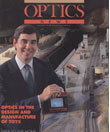
October, 1989 Issue
Feature Articles
Bringing "Fiber-to-the-Home" has recently captivated the imagination and business instinct of the telecommunications industry and equipment manufacturers. With the prospect of fiber being widely deployed in the "last mile" of the telephone network, and with customers having access to nearly unlimited bandwidth, some see an opportunity for a large variety of novel broadband services with ensuing new revenue possibilities. Others see an opportunity for the mass-fabrication of optical communication equipment and new consumer electronics. In fact, by providing end-to-end fiber connectivity, Fiber-to-the-Home (FFTH, including business and commercial customers), is providing nothing less than the physical infrastructure for the broadband telecommunications network of the much-heralded "Information Age" of tomorrow.
by Peter Kaiser and Paul W. ShumateThe education-training continuum: Which way optics?
Educators in optics face a rudimentary dilemma. As in similar disciplines, there are basically two philosophies toward teaching: the theoretically-based path, often preferred by basic researchers and the like; and the highly-focused, task-oriented path, generally the choice of industrialists. Academics make decisions every day on how to best educate their students and how to advance their field. Schools, through the programs they offer, typically align themselves along one of these two paths. While undergraduate, graduate, and technical programs all play a part in shaping the field of optics, undergraduate education will be the focus of this article.
by C. Yashar OzberkmenPeople in Kobe, Japan were "pretty excited and surprised that it worked," according to AT&T Bell Labs research team leader Jack Jewell. Kobe was the site of this summer's International Conference on Integrated Optics and Optical Fiber Communications (IOOC '89) where Jewell presented the group's most recent work: low threshold electrically-pumped vertical-cavity surface-emitting micro-lasers, or surface emitting diode lasers, or, as people are beginning to call them, μ-lasers.
by C. Yashar OzberkmenU.S. closer to international optics standards with implementation of 1982 policy
About a year ago, we noted here that the U.S. would soon have de facto international optical standards. This eventuality is now one step further along thanks to the U.S. Army Material Command's efforts to implement a 1982 Office of Management and Budget (OMB) circular.
by Robert E. ParksMore than just child's play: Optics in the design and manufacture of toys
At first, the brightly colored Fisher-Price® sunglasses worn by your child appear to be little more than play items. But, in reality, these glasses are the result of intensive optics design and manufacturing engineering considerations. The same is true for many other optical toys— binoculars, play "cameras," video products, and telescopes—developed by Fisher-Price®, Lionel® Trains, and other quality-conscious manufacturers.
by Stephen Fantone

![Manual probe system with needles for test of semiconductor on silicon wafer. [A. Morozov / Getty]](https://opnmedia.blob.core.windows.net/$web/opn/media/images/articles/2025/1125/departments/202511-cover-web.jpg?ext=.jpg)
![Researcher Clara Saraceno in the lab. [Image by Carsten Behler Photography]](https://opnmedia.blob.core.windows.net/$web/opn/media/images/articles/2025/1025/departments/202510-cover-web.jpg?ext=.jpg)
